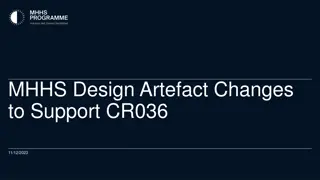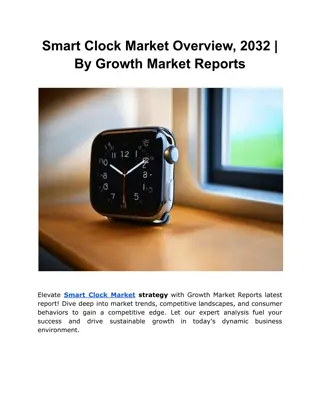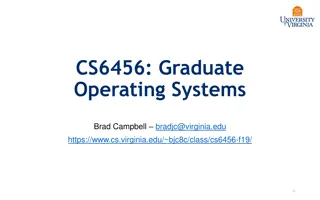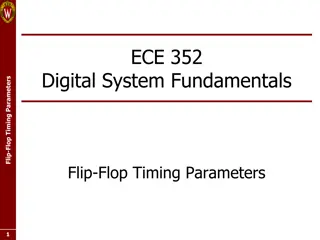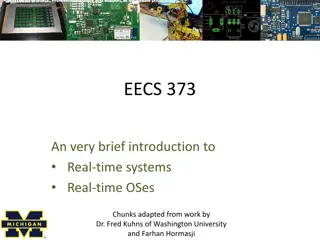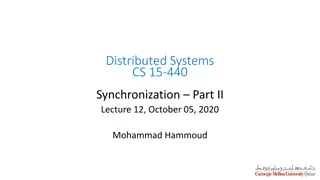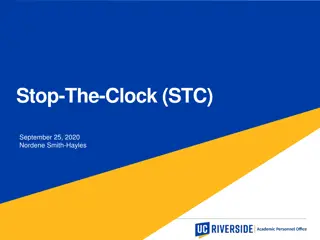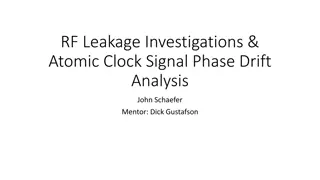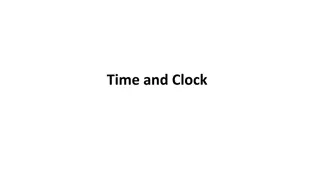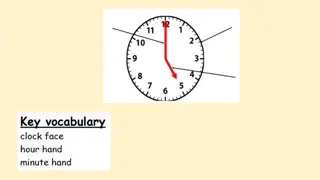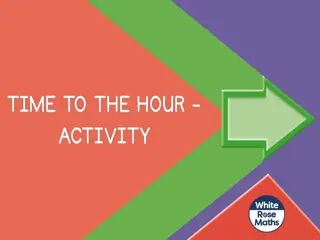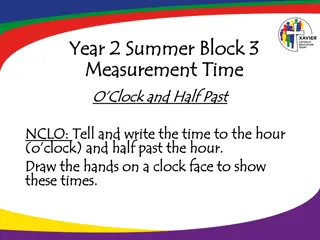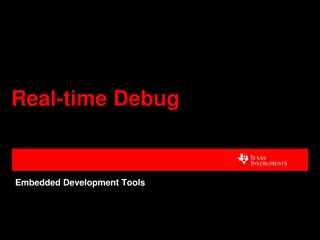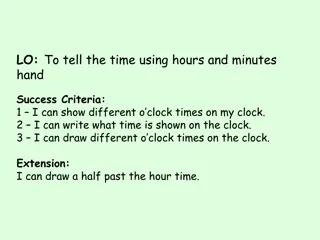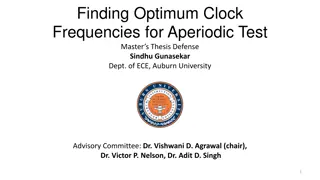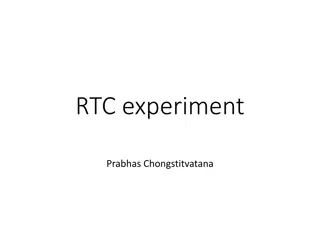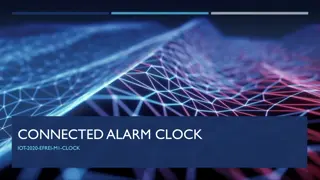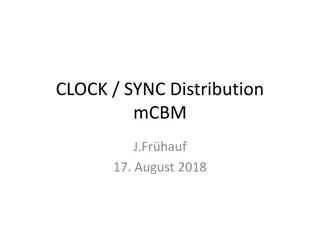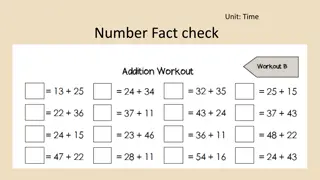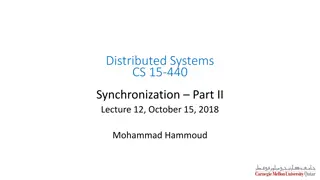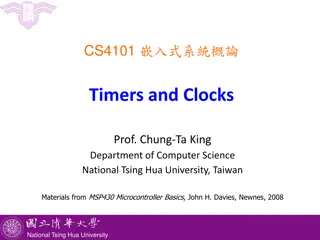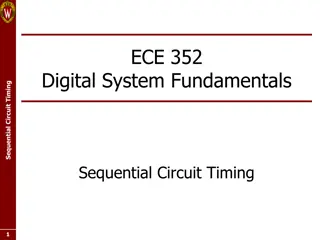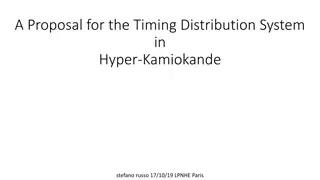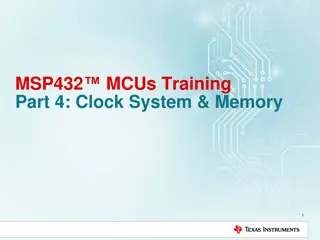Making invisible skills visible and valued
CLOCK is an international professional development framework that enables creative individuals to showcase their professional capabilities. The CLOCK Programme uncovers and recognizes invisible skills, mapping them to international professional and higher education levels.
3 views • 10 slides
Clock Change Impacts on MHHS Design Artefacts for CR036
Detailed redline changes to MHHS Design Artefacts for CR036 related to the use of midnight clock time for appointments and readings. Includes updates to business process maps, data catalogue definitions, and interface catalogue revisions to align with the new requirements.
7 views • 16 slides
Smart Clock Market Overview, 2032 | By Growth Market Reports
The smart clock market was valued at USD 735.32 Million in 2022 and is projected to reach USD 5557.96 Million by 2031, expanding at a CAGR of 25.2% during the forecast period, 2023 \u2013 2031.
13 views • 5 slides
Understanding Referral to Treatment (RTT) Quality Standards
Referral to Treatment (RTT) Quality Standards, also known as RTT 18 Weeks, is a vital component of the NHS Constitution that guarantees patients a legal right to timely diagnosis and treatment within 18 weeks of referral. It encompasses various stages in a healthcare pathway, each assigned an RTT co
1 views • 12 slides
Understanding Real-Time Systems and Operating Systems
Real-time systems in computing refer to the concept of task execution meeting specific deadlines, with examples including process control in industrial plants, robotics, air traffic control, and more. Tasks in real-time systems have defined release, schedule, completion times, and deadlines, with ru
0 views • 46 slides
Employee Time Tracking Guide for Cleveland State University Hourly Workers
This guide provides step-by-step instructions for hourly employees at Cleveland State University to clock in using Kronos Workforce Timekeeper and access their time records through myTime. It explains how to record timestamps, punch in or out for single or multiple jobs, view timecards, and check ac
0 views • 5 slides
Understanding Counters in Sequential Circuits
Counters in sequential circuits are crucial components used for counting clock cycles and measuring time intervals. They are composed of flip-flops that progress through a sequence of states based on clock pulses. This sequential circuit has no inputs other than the clock pulse and relies on its int
1 views • 22 slides
Understanding Flip-Flop Timing Parameters in Digital Systems
In digital systems, flip-flop timing parameters are crucial for proper operation. Synchronous inputs must remain stable before and after the clock edge to ensure correct storage of values. Clock frequency, setup time, hold time, and propagation delay play key roles in signal integrity. By considerin
0 views • 9 slides
Understanding Sequential Counters in Digital Circuits
Sequential counters, comprised of flip-flops, are essential in digital circuits for counting clock cycles. They advance through states based on clock pulses and can measure time intervals. The circuit's output state solely depends on its present state, with transitions occurring at each clock pulse.
0 views • 22 slides
Introduction to Real-Time Systems and Real-Time OSes
Real-time systems are defined by the critical nature of timely results, where correctness depends not just on computation but also on when results are produced. Characteristics include timing constraints, deadlines, and different types of tasks categorized based on timing patterns. Understanding sof
0 views • 21 slides
Game Clock Operator Guidelines and Responsibilities
Guidelines and responsibilities for game clock operators, including dress code, rules study, pre-game preparations, and in-game conduct. Operators must be qualified, familiar with game timing procedures, and maintain focus on accurate timekeeping. Follows procedures for pre-game, game-time operation
0 views • 19 slides
Understanding Network Time Protocol (NTP) for Clock Synchronization in Distributed Systems
Dive into the intricacies of Network Time Protocol (NTP) and its role in achieving precise clock synchronization in distributed systems. Explore concepts such as hierarchical organization of NTP servers, NTP protocol operation, and the significance of accurate time tracking for seamless system coord
1 views • 38 slides
The Enigmatic Clock Tower
In a captivating narrative inspired by The Clock Tower, a mysterious girl in a red dress alters reality by manipulating time through a magical clock tower window. As she embarks on a journey to restore the grey world outside, unexpected twists and deep realizations unfold, leaving readers spellbound
0 views • 16 slides
Understanding Stop-The-Clock (STC) Policy in Academic Personnel Offices
The Stop-The-Clock (STC) policy allows assistant-level academic appointees to extend their evaluation period for Associate Professor appointments. It also provides for additional time off the clock for significant life events like childbirth or serious health conditions. Learn about eligibility, pro
0 views • 8 slides
RF Leakage Investigations & Atomic Clock Signal Phase Drift Analysis
RF signals ranging from 100 kHz to 150 MHz are utilized for achieving resonance in optical cavities. DC Ground Isolation Units help decouple DC grounds and shield leakage. Spectrum analysis using RF analyzers reveals peaks possibly from neighboring balun leakages. Solutions involve increasing capaci
0 views • 14 slides
Determining OBS Clock Drift Using Seismic Interferometry
Determining clock errors in Ocean Bottom Seismometers (OBSs) is crucial for accurate seismic data recording. This study presents a method using ambient seismic noise and seismic interferometry to correct clock drift in OBSs. The program developed employs Python/Fortran to analyze seismic data direct
0 views • 10 slides
Understanding Time, Clock Synchronization, and Atomic Clocks
Delve into the intricacies of time and clock synchronization, from the rotation of the Earth to atomic clock standards. Explore the importance of physical clock synchronization and the practical implications on technologies like GPS. Uncover the terminology and methodologies involved in achieving pr
0 views • 24 slides
Low-Latency Inter-Datacenter State Machine Replication Using Clock-RSM
Clock-RSM introduces a low-latency approach to inter-datacenter state machine replication by utilizing loosely synchronized physical clocks. This method ensures strong consistency, fault tolerance, and fast failover in a geo-replication environment. By overlapping ordering and replication using phys
0 views • 29 slides
Fun with Calendars and Clocks
Explore the world of calendars and clocks with activities, questions, and fascinating facts. From learning the number of days in different months to understanding how the hands of a clock work, dive into the concepts of time and organization. Engage in interactive tasks like marking birthdays, natio
0 views • 25 slides
Understanding Clock Hands Position at Different Times
Explore how the minute hand points to specific positions on a clock face at different times such as "at o'clock" and "at half past." Visual representations provide a clear understanding of these concepts.
0 views • 6 slides
Understanding Time Through Clocks
Explore the significance of knowing the time, discover the numbers on a clock, compare different clock drawings, learn how to read time using clock hands, identify various clock times, and understand activities associated with specific clock times.
0 views • 13 slides
Enhancing Time-telling Skills with Clock Faces and Hands
Explore activities for teaching time-telling to children using clock faces and hands at o'clock, half-past, quarter-past, and quarter-to times. Engage in vocabulary building, key questions, fluency exercises, and reasoning/problem-solving tasks to enhance understanding and mastery of telling time.
0 views • 54 slides
IEEE 802.11-18-1269-00-00az Clock Synchronization Investigation
In July 2018, a document was presented by Feng Jiang et al. from Intel Corporation focusing on clock synchronization between ISTA and RSTA in IEEE 802.11-18-1269-00-00az standard. The document delves into the impact of sampling clock errors on range estimation, carrier frequency synchronization in 1
0 views • 10 slides
Understanding Real-time Debug Techniques for Embedded Development
Real-time debugging in embedded systems involves different modes like stop mode and real-time mode, each offering unique capabilities for accessing memory, registers, and handling interrupts. This technique allows developers to examine and modify memory contents while the processor is running, enabl
0 views • 32 slides
What's the Time, Mr. Wolf? - Fun Clock Times for Kids
Enjoy a playful journey through the clock times with Mr. Wolf in this interactive educational content. Explore different clock times such as 3 o'clock, 5 o'clock, 9 o'clock, 6 o'clock, 12 o'clock, 8 o'clock, 1 o'clock, 11 o'clock, and more. Engage in a visual quiz to identify which clock corresponds
0 views • 15 slides
Learning to Tell Time with Hours and Minutes Hands
Explore how to tell time using a clock with hands indicating hours and minutes. Learn to read different o'clock times, draw them, and understand concepts like half-past. Engage in activities to enhance understanding of time-telling skills.
0 views • 14 slides
Time-related Educational Activities for Kids
Engage kids in learning about days of the week, telling time, and understanding clock hands with fun and interactive worksheets and questions. The content includes identifying days of the week, numbers, clock hands, and time-telling scenarios, making learning enjoyable for children.
0 views • 16 slides
Learning to Tell Time With Ms. Azmira Akter at Rajbari Model Govt Primary School
Join Ms. Azmira Akter, an assistant teacher at Rajbari Model Govt Primary School, as she teaches Class Four students English and how to tell time. The lesson includes learning outcomes such as reading correctly, telling time on a clock, and identifying similar meanings. Through engaging activities a
0 views • 15 slides
Finding Optimum Clock Frequencies for Aperiodic Test
Finding the best clock frequencies for aperiodic testing in integrated circuits is crucial for reducing test time and costs. This study by Sindhu Gunasekar explores the use of aperiodic clock testing to optimize test cycles and minimize power dissipation, ultimately improving testing efficiency.
0 views • 29 slides
Understanding RTC Experiments with DS1307 for Arduino
Delve into the world of real-time clock (RTC) experiments using the DS1307 serial real-time clock with this comprehensive guide. Learn how to write to and read from the RTC, set up the board with Arduino, utilize interrupts for RTC reading, and more through step-by-step instructions and insightful v
0 views • 15 slides
Introducing Connected Alarm Clock IoT Project
Explore the innovative Connected Alarm Clock IoT project developed by EFREI-M1-CLOCK students. This project combines traditional alarm clock features with IoT technology, allowing users to set unlimited alarms remotely. The system includes equipment such as RTC DS3231, Arduino UNO, Wi-Fi Rev2, and o
0 views • 7 slides
Clock Synchronization Distribution For Data Taking Systems
The content details the clock synchronization distribution system for data taking systems requiring specific clock frequencies for various subsystems to ensure synchronous data processing. It covers the setup, external clock relationships, and generation specifics involving different clock frequenci
0 views • 10 slides
Learning to Tell Time Using Quarter to the Hour
This educational material focuses on teaching students how to tell time using quarter to the hour on an analogue clock. It covers key vocabulary, such as time, clock, hour hand, minute hand, quarter past, and quarter to. The content includes engaging activities, stem sentences, and a twist exercise
0 views • 11 slides
Understanding Distributed System Synchronization and Logical Clocks
Continuing from the previous lecture on time synchronization, this session delved into logical clock synchronization, mutual exclusion, and election algorithms in distributed systems. Logical clocks, such as Lamport's Clock and Vector Clock, play a crucial role in defining the order of events withou
0 views • 33 slides
Embedded Systems: Timers, Clocks, and Real-Time Control
Explore the role of timers and clocks in embedded systems, covering topics such as real-time monitoring, time-based control, and challenges with software delay loops. Learn about using hardware counters for time references and integrating timers as I/O devices in clock systems.
0 views • 48 slides
Understanding Sequential Circuit Timing and Clock Frequency
Sequential circuit timing is crucial for designing digital systems. The minimum clock period, slack values, clock frequency, and critical paths play key roles in determining the operational speed and performance of sequential circuits. By analyzing flip-flop timing parameters, combinatorial logic de
0 views • 20 slides
Proposal for Timing Distribution System in Hyper-Kamiokande
A proposal for a timing distribution system in the Hyper-Kamiokande project, focusing on implementing a synchronous, phase-deterministic protocol with bidirectional data exchange. The system includes a master clock generator, atomic clock, and multiple distributors to synchronize various components.
0 views • 13 slides
Guide to Using a Digital Clock for Timekeeping
Learn how to set up and operate a digital clock for timekeeping purposes. This guide covers turning on the clock, setting the main clock, using basic clock functions, managing penalties, recording scores and goals, and utilizing the time-out feature. Familiarize yourself with the menu options and es
0 views • 8 slides
Understanding Clock System, Memory Features, and Flash Operations in MSP432 MCUs
The MSP432 part 4 training covers the clock system's flexibility, offering a wide range of clock sources for high-speed and low-power operations. It highlights high-accuracy, tunable DCO with various frequency ranges and their calibration. Additionally, it discusses memory features such as flash siz
0 views • 9 slides
Stylish Resin Wall Clock
Add a contemporary flair to your decor with a resin wall clock. Available in vibrant colors and artistic designs, it\u2019s perfect for modern interiors. Lightweight and versatile, this clock enhances any room with its unique style and functionality.
0 views • 1 slides

